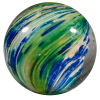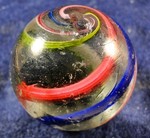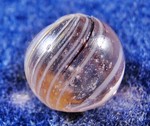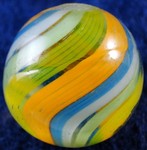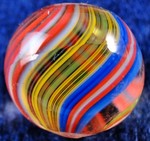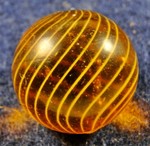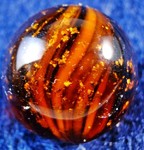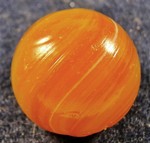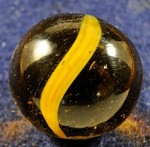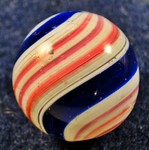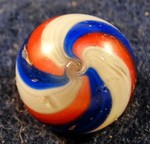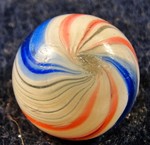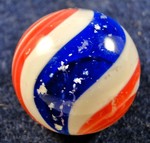Other Swirls
The category Banded Swirls and Coreless Swirls tends to be used interchangeably. These are swirls that have an outer layer of bands or strands, but no inner core. If the outer layer appears to be evenly spaced, subsurface, and of a type usually found as the outer layer of other types of swirls, then they are usually termed coreless. If the outer layer is on the surface, irregular in spacing and band width, and not the type of outer layer typically seen on a swirl, then they are termed banded. They tend to lack the pizazz of other types of swirls and are valued lower. Coreless swirls, as opposed to banded swirls, tend to carry somewhat more value.
Banded and Coreless Swirls are found with colored base glass (usually blue or green), about as often as they are found in clear. There is not much difference in
value between the different colors.
Joseph’s Coat Swirls (below) are a specialized variety of banded swirls. If the bands are very thin and packed closely together, then it is a Joseph’s Coat swirl.
Otherwise, it is a Banded Swirl.
Click on any image below to display a full-screen version of it.
Joseph’s Coat Swirls are swirls that have an outer layer of glass that is composed of variously colored similar-width complete strands, packed very closely together.
Better examples have no clear spaces in between the strands. Some examples do have clear spaces, In some cases, these appear to be part of the design. There are
usually some strands in the inner core that can be seen through the spaces. Generally, the more colors in the marble, the more valuable it is.
Joseph’s Coat Swirls have either dark, earthy colors or bright English- style colors. The base glass of a Joseph’s Coat can either be clear or colored. The outer layer can be
Swirl type (bands and strands) or End of Day type (stretched flecks of glass).
Click on any image below to display a full-screen version of it.
There are several types of swirls that are specialized examples of banded or coreless swirls.
A Gooseberry Swirl is a transparent glass swirl with equidistantly spaced white subsurface strands. The base glass is usually honey amber. There are
also marbles with base glass that is green, clear or blue. These are much rarer than the amber.
A Caramel Swirl is a marble with a dark transparent brown base glass and opaque white bands or swirls in it. Some examples have mica in them. These are rarer
than those without mica.
Custard Swirls and Butterscotch Swirls have wide translucent brown/pink strands on the surface. Custard Swirls have a semi-opaque
creamy yellow base. Butterscotch Swirls have a semi-opaque creamy brown-yellow base.
Cornhusk Swirls are a light transparent honey yellow glass with a single wide white band. They are more common than the miscellaneous
swirls discussed above.
Click on any image below to display a full-screen version of it.
A Peppermint Swirl is another specific type of banded swirl that has subsurface bands.
The marble has two wide opaque white bands, alternating with two thinner translucent blue bands. There are usually two or three transparent pink stripes on
each white band.
Less common are marbles with a single transparent pink stripe on each white band. Some marbles exist that have two pink bands, which are the same width
as the two blue bands. These are called “beach ball” and are much rarer than the other types. There have also been a few marbles found with an odd number of pink bands (three or five). These
are rare.
Marbles with mica in the blue bands are very rare. There have also been some marbles found with a blue strand in one of the pink strands or with a green strand in the blue band.
These are also very rare, but do not command any higher value.
Click on any image below to display a full-screen version of it.


